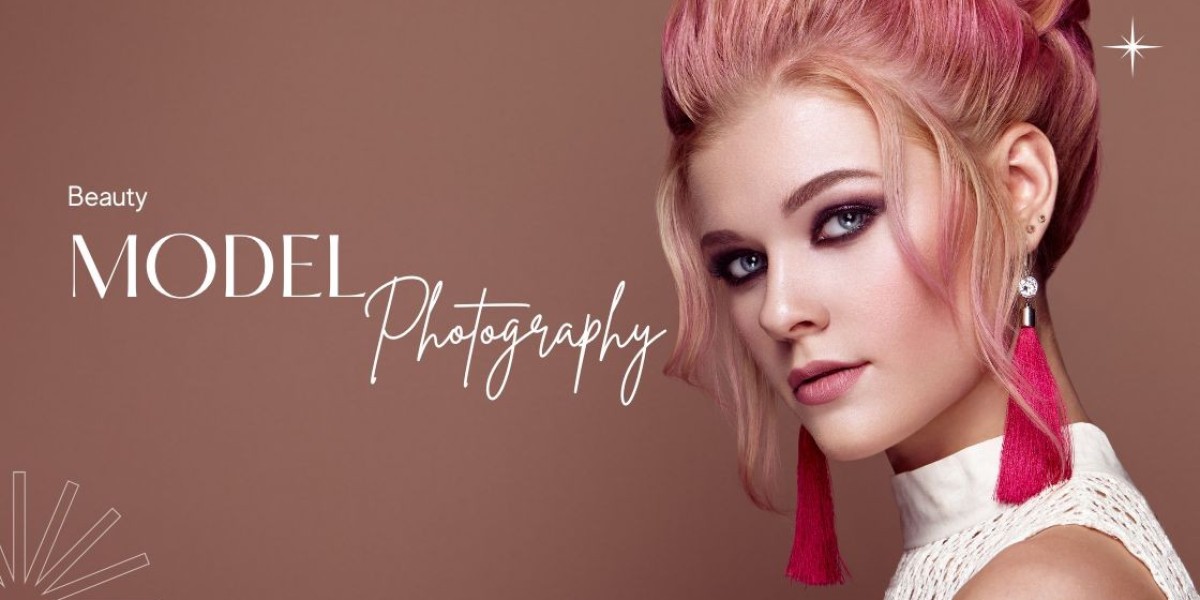In today's digital age, beauty model photography holds immense significance as a means of visual communication and self-expression. This form of photography, coupled with the art of retouching, shapes the way we perceive beauty and aesthetics in the modern world.
A. Growing Significance of Beauty Model Photography
In a world driven by visual content, beauty model photography has become a vital tool for conveying individuality and style. Social media, advertising, and personal branding rely heavily on captivating visuals that transcend boundaries and resonate with diverse audiences.
B. Importance of Retouching for Desired Aesthetics
Retouching serves as the digital canvas that enhances and refines the captured image. In beauty model photography, it doesn't distort reality but rather highlights the subject's innate beauty. This collaboration between photography and retouching crafts images that evoke emotions and capture the viewer's attention, creating a powerful visual narrative.
As we delve into this realm, we unravel the fusion of artistic vision, technical finesse, and ethical considerations that shape the world of beauty model photography and retouching in our digitally-driven age.
The Essence of Beauty Model Photography
Beauty model photography is a dynamic interplay of aesthetics, storytelling, and visual representation. It encapsulates the essence of human allure and provides a canvas for creative exploration and interpretation.
A. Defining Beauty in Model Photography
In the context of model photography, beauty is more than just skin deep. It transcends conventional notions and encompasses individuality, confidence, and authenticity. Beauty is found not only in symmetrical features but also in the unique characteristics that make each subject distinct. The lens captures not just appearances, but also the emotions and stories that lie within.
B. Natural Beauty vs. Artistic Interpretations
One of the intriguing aspects of beauty model photography is the choice between capturing natural beauty and creating artistic interpretations. While some photographers seek to preserve the raw authenticity of their subjects, others aim to weave a narrative through artistic manipulation. Both approaches have their merits, offering viewers either a glimpse into unfiltered reality or an immersive journey through creative imagination.
C. Role of Lighting, Composition, and Posing
The interplay of lighting, composition, and posing is at the heart of beauty model photography. Lighting, whether natural or artificial, can sculpt features, create depth, and evoke moods. Composition guides the viewer's eye, framing the subject in a way that resonates with the intended message. Posing is an art in itself, emphasizing strengths and downplaying insecurities, while also conveying emotion and personality.
These elements collaborate harmoniously to accentuate the subject's features, revealing the intricate nuances of expression, character, and style. A well-executed photograph transcends the superficial and delves into the realm of storytelling, inviting viewers to connect on a profound level.
The Process of Model Photography
The process of creating captivating beauty model photography involves meticulous planning, collaboration, and attention to detail. From conceptualization to execution, each step contributes to the final visual narrative.
A. Pre-Shoot Preparation
Before the camera clicks and the lights shine, a significant amount of groundwork is laid to ensure a successful beauty model photography session. Pre-shoot preparation is the cornerstone of achieving the desired outcome.
1. Conceptualizing the Shoot and Setting Objectives
Every compelling photograph begins with a concept. Photographers delve into the creative process, envisioning the story they want to convey. Whether it's an ethereal fairy tale or a bold statement of empowerment, the concept sets the tone for the entire shoot. Clear objectives help guide the photography team toward a cohesive vision.
2. Choosing the Right Model and Makeup Artist
Selecting the perfect model is paramount in bringing the concept to life. Models with features that align with the envisioned aesthetic enhance the authenticity of the final image. Equally important is the role of the makeup artist, who translates the photographer's vision onto the canvas of the subject's face, accentuating their unique beauty.
3. Selecting Appropriate Wardrobe and Props
Wardrobe and props are essential elements that contribute to the story being told. The choice of clothing can evoke a specific era, mood, or style, while props add depth and context to the narrative. These carefully curated elements enrich the visual experience, elevating the overall impact of the photograph.
B. During the Shoot
A successful model photography session hinges on the photographer's ability to guide the process, fostering creativity and capturing captivating images. This phase involves dynamic interaction with the model and the environment to achieve the desired results.
Creating a Comfortable and Collaborative Atmosphere:
Establishing a relaxed and positive atmosphere is essential to elicit genuine expressions from the model. Clear communication and a friendly demeanor help the model feel at ease, allowing their personality to shine through. Building a connection of trust and respect encourages the model to share their ideas, enabling a collaborative exploration of poses, expressions, and concepts.
Experimenting with Various Poses and Angles:
Variety in poses and angles contributes to a diverse range of images that showcase the model's versatility. Encouraging the model to try different poses and angles allows for the discovery of unique compositions that highlight their strengths. This experimentation encourages natural movements and expressions, capturing candid moments that convey authenticity.
Utilizing Different Lighting Techniques to Enhance the Subject's Features:
Lighting is a powerful tool that can transform the mood and impact of an image. Photographers must strategically use different lighting setups to enhance the model's features and create visual interest. Whether using natural light, studio lighting, or a combination of both, adjusting light direction, intensity, and quality can sculpt the model's appearance and add depth to the photograph.
The Art of Retouching in Beauty Model Photography
Retouching plays a vital role in elevating beauty model photography to a polished and visually appealing level. It involves carefully enhancing and refining various aspects of the image while maintaining the natural beauty of the subject. A skillful approach to retouching can significantly contribute to the overall impact of the final photographs.
A. Understanding the Purpose of Retouching
Beauty retouching serves as a creative and technical process to enhance the visual appeal of beauty model photography, without compromising the authenticity of the subject. The goals of retouching include:
Enhancing Skin Texture and Complexion:
Retouching allows photographers to smooth out minor blemishes, uneven skin tones, and imperfections, creating a flawless yet natural-looking skin texture. This process preserves the model's skin while ensuring a radiant appearance.
Refining Facial Features and Proportions:
Subtle adjustments can be made to facial features, such as refining jawlines, enhancing eyebrows, or correcting minor asymmetries. These refinements accentuate the model's natural beauty while maintaining their distinctive characteristics.
Eliminating Distractions and Imperfections:
Unwanted distractions, such as stray hairs or small objects in the background, can be removed through retouching. This ensures that the viewer's focus remains on the model's features and the intended narrative.
B. Techniques and Tools for Retouching
The art of retouching involves utilizing various techniques and tools to achieve a polished yet authentic look in beauty model photography.
Frequency Separation for Skin Retouching:
Frequency separation is a technique that allows retouchers to work on different frequencies of an image separately. High-frequency layers target texture details, while low-frequency layers address color and tone adjustments. This approach enables precise retouching of skin imperfections while preserving natural skin texture.
Dodging and Burning to Add Depth and Dimension:
Dodging and burning involve selectively lightening and darkening specific areas of an image to create depth and dimension. This technique enhances the contours of the model's face, accentuates features, and adds a three-dimensional quality to the photograph.
Color Correction and Tonal Adjustments for a Polished Look:
Retouchers can fine-tune color balance, saturation, and contrast to achieve a harmonious and polished color palette. Tonal adjustments help maintain a balanced range of shadows and highlights, ensuring a well-exposed and visually appealing final image.
Maintaining Ethical Standards in Beauty Model Photography
Ethical considerations are essential in beauty model photography to ensure that the industry promotes positive values, respects individuals' dignity, and embraces diversity. Upholding ethical standards not only enhances the integrity of the work but also contributes to a more inclusive and socially responsible approach to photography.
A. Balancing Enhancement with Authenticity
Striking the right balance between enhancing images and maintaining the authenticity of the subject is crucial in beauty model photography. While retouching can enhance certain aspects of an image, excessive alterations that distort the model's appearance can lead to a loss of authenticity. Photographers and retouchers should aim to enhance natural beauty without altering the model's identity or creating unrealistic standards.
B. The Debate Surrounding Excessive Retouching and Body Image Concerns
The use of excessive retouching in beauty model photography has sparked debates about body image and unrealistic beauty standards. Overly retouched images can contribute to harmful societal perceptions and negatively impact individuals' self-esteem. It's important to consider the potential consequences of retouching and make thoughtful decisions that prioritize the well-being and mental health of both models and viewers.
C. Embracing Diversity and Inclusivity in Beauty Model Photography
Diversity and inclusivity are vital ethical considerations in beauty model photography. The industry should reflect a wide range of body types, ethnicities, ages, and gender identities. By embracing diversity, photographers contribute to a more representative portrayal of beauty that resonates with a broader audience and challenges conventional norms.
Photographers, stylists, and retouchers can take the following actions to uphold ethical standards:
Transparent Communication: Maintain open communication with models about the extent of retouching and the desired outcomes. Models' input and comfort should be prioritized throughout the process.
Responsible Retouching: Use retouching techniques to enhance natural features while respecting the subject's identity. Avoid altering body shapes or features in ways that perpetuate unrealistic ideals.
Critical Self-Reflection: Regularly assess your work to ensure that it aligns with ethical values. Question whether retouching choices contribute positively to the final image or if they perpetuate harmful stereotypes.
Embrace Inclusivity: Seek out a diverse range of models that represent various backgrounds, body types, and identities. This approach enriches the visual narrative and promotes inclusivity.
Advocate for Change: Use your platform to advocate for responsible practices within the industry. Raise awareness about the impact of excessive retouching and encourage discussions around body positivity and diversity.
Conclusion
Beauty model photography thrives on the symbiotic relationship between capturing raw beauty and skillful retouching. This balance enhances images while preserving authenticity. Ethical considerations, such as celebrating diversity and promoting authenticity, are crucial for positive impact.
Embracing emerging trends must go hand in hand with upholding ethical standards. The industry's evolution demands responsible practices that prioritize body positivity, mental well-being, and inclusivity. Navigating change with ethical awareness shapes a dynamic and socially conscious beauty model photography industry.
From conception to final product, the journey reflects creativity, collaboration, and ethical consciousness. The combination of photography, retouching, and ethical standards creates an industry that captivates while promoting positive values worldwide.








